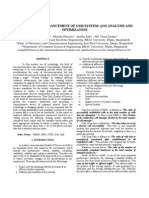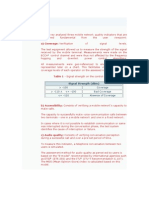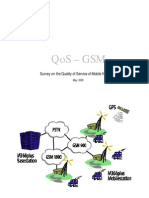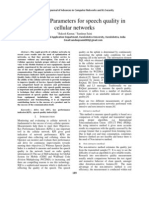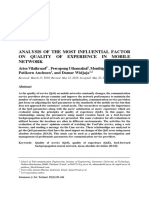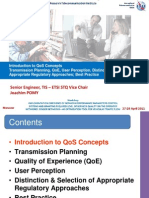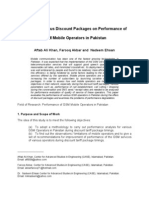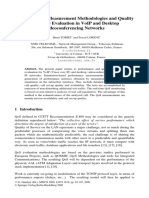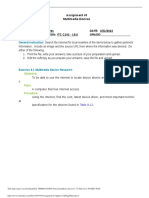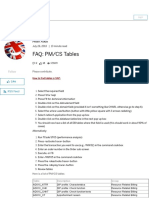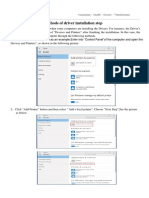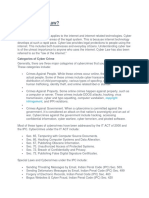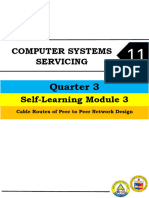Communications for all in East Africa
EACO GUIDELINES FOR
QUALITY OF SERVICE IN
MOBILE AND FIXED
NETWORKS FOR VOICE
SERVICE
MEASUREMENT AND STATISTICAL METHODOLOGIES
Prepared by EACO
July 2017
�Table of Contents
1. Introduction ................................................................................................................... 3
2. Scope ............................................................................................................................. 3
3. References ..................................................................................................................... 4
Recommendation ITU-T E.804: « QoS aspects for popular services in mobile networks” ...... 4
Recommendation ITU-T P.862.3: "Application guide for objective quality measurement
based on Recommendations P.862, P.862.1 and P.862.2". ..................................................... 4
ETSI EG 202 765-1: « Speech and multimedia Transmission Quality (STQ); QoS and
network performance metrics and measurement methods; Part 1: General considerations ». .. 4
ETSI TS 102 250-4: « Speech and multimedia Transmission Quality (STQ); QoS aspects for
popular services in mobile networks; Part 4: Requirements for Quality of Service
measurement equipment» ...................................................................................................... 4
4. Abbreviations and Acronyms ......................................................................................... 4
5. Guideline ....................................................................................................................... 4
2
� 1. Introduction
The term Quality of Service (QoS) is extensively used today, not just in the
telecommunication world in which it has its roots, but increasingly regarding
broadband, wireless and multimedia services that are based on the IP protocol.
Networks and systems are gradually being designed in consideration of the end-
to-end performance required by user applications; however, the term QoS is
usually not well-defined, is used loosely or, worst of all, misused. Therefore,
guidance is needed on how to understand and apply the term QoS.
The term "Quality of Service" addresses technical as well as non-technical
aspects affecting a service. Different concepts and guidance have been
developed to cover various interests and viewpoints of all parties of
telecommunications service market, i.e. users, service providers, network
operators, manufacturers and regulators.
This guideline provides to EACO countries, a guidance for “Quality of Service
in Mobile and Fixed Networks for Voice Service”. The guideline is formed by
two documents (Part1: Definitions & Thresholds of QoS Parameters and Part2:
Measurement and Statistical Methodologies) which is discussed in this
document.
2. Scope
This guideline covers the QoS of voice service in Mobile and fixed networks
communication. This guideline is formed by two parts (Part 1 and 2) as follows:
Part 1: focuses on harmonising “Definitions and Thresholds of QoS
Parameters” for EACO member states”.
Part 2: focuses on harmonisation of “Measurement and Statistical
methodologies for EACO member states”.
This document covers part 2 only; part 1 is covered separately.
3
� 3. References
Recommendation ITU-T E.804: « QoS aspects for popular services in mobile
networks”
Recommendation ITU-T P.862.3: "Application guide for objective quality
measurement based on Recommendations P.862, P.862.1 and P.862.2".
ETSI EG 202 765-1: « Speech and multimedia Transmission Quality (STQ);
QoS and network performance metrics and measurement methods; Part 1:
General considerations ».
ETSI TS 102 250-4: « Speech and multimedia Transmission Quality (STQ);
QoS aspects for popular services in mobile networks; Part 4: Requirements for
Quality of Service measurement equipment»
4. Abbreviations and Acronyms
EACO : East African Communication Organisation
NRA : National Regulatory Authorities
ITU : International Telecommunication Union
ITU-T : International Telecommunication Union - Telecoms
QoS : Quality of Service
QoE : Quality of Experience
ETSI : European Telecommunications Standardisation Institute
5. Guidelines
5.1 QoS Definition
The International Telecommunication Union (ITU) under its recommendation
ITU-T E.800 defines QoS as “Totality of characteristics of a
4
�telecommunications service that bear on its ability to satisfy stated and implied
needs of the user of the service.”
5.2 Principles of the QoS Methodology
This guideline takes into account the different phases of service provision on the
mobile networks as defined by ITU-T and ETSI below:
i. Network Availability: Probability that the services are made available to
users by a mobile network
ii. Network Accessibility: Probability that the user can successful register on
the network, which delivers the service.
iii. Service Accessibility: Probability that the user can access the service he
wants to use.
iv. Service Integrity: This is the QoS during service provision e.g. speech
quality for voice and bit error rate for data among others.
v. Service Retainability: This describes the availability of service provision
until termination in accordance with or against the will of the user. KPIs
under this phase include call drop rate and the data cut-off ratio.
This guideline is based on the following principles:
5.2.1 Impartiality and objectivity:
a) The SIMs to be used must be standard consumer SIMs and without any
limitations e.g. fair use, amount consumed, promotion limitations to
mention but a few.
b) Measurements will be carried out under the same conditions for all
concerned licensees.
c) The schedule for measurements shall only be known by the NRA i.e.
Licensees should not be made aware in advance of where and when tests
will be performed.
d) Identical terminal equipment shall be used for all operator networks under
test. In the process, SIM rotation shall be implemented to cover for any
differences between terminals.
e) To eliminate human error, tests will be carried out automatically as much
as feasibly possible.
5.2.2 Representativeness
5
� a) The parameters selected shall reflect the most common KPIs that affect
directly consumer experience.
b) The measurement schedule shall take into consideration traffic variations
over the hours of a day, and the days of the week
c) Population distribution across the country shall be taken into
consideration when deciding on the sample size
5.2.3 Consistency and accuracy
a) The selected sample size shall be statistically representative and
accurately portray the results.
b) The Test equipment used shall not have any technical obstacle
considering the available technologies or KPIs to be measured.
c) A common test platform shall be used in making observations and
collecting field data
5.3 Data Sources
Data under this Guideline shall be collected from the following sources:
i. Data collected through administrative reporting:
ii. Data collected within networks measurements
iii. Data collected through drive / walk tests
5.4 Quality of Service Key Performance Indicators (KPIs)
The QoS indicators/KPIs will be as per the approved EACO Guidelines namely:
a) EACO Guidelines for Quality of Service for Voice Service in Mobile and
Fixed Networks
b) EACO Guidelines for Quality of Service of Data Services in Mobile
Networks
5.5 Measurement Considerations
The following shall be taken into account when undertaking QoS monitoring
5.5.1 Number of observations
6
�This is the sample size that should be representative and big enough to obtain an
acceptable accuracy level
5.5.2 Day and time when measurements are done
Monitoring should take into account traffic fluctuations during the time of day
and day of the week. Observations should however be avoided at night time,
public holidays, weekends and other peculiar event times. This consideration
does will not however have an effect on the coverage KPI.
5.5.3 Location i.e. indoor/outdoor, city or rural area, ‘in car’ etc.
Samples should be collected indoor, outdoor and ‘in-car’ in both rural and urban
centres based on the population density.
5.5.4 Position in the rooftop box
The Terminal equipment shall be positioned vertically on a stable and adapted
base to provide the best possible transceiver radio conditions. The antennas
shall be fixed in a way that complies with recommendations given in ETSI TS
102 250-4 V2.2.1 section 5.5.
5.5.5 Charging profile
Pre-paid SIM cards shall be used for mobile networks. The most popular cards
between pre-paid and post-paid shall be used for fixed wired and wireless
networks depending on a country.
5.5.6 Speed while driving
During measurements, speed shall be limited to 80 km/h. The drive test
speeds should never exceed the specified road speed limits for the particular
roads. Consideration should also be made on the path terrain and condition of
the road.
5.5.7 Electrical supply
Electrical supply of the test equipment must be guaranteed by use of a back-up
battery to ensure autonomy of the device and optimal radio conditions.
5.5.8 Calls and timers:
The following values, based on ETSI TS 102 250-5 section 4.2.1.1, apply:
● Call duration: 120 s (currently 90 s ) to be reviewed at pilot.
7
�● Call window: 165 s (means: call duration + 30 s (for the setup and release
phas- es) + 15 s for the minimum pause interval)
● Call set up time out: 20 s
5.6 Periodic reporting and publication
The following principles will apply:
a) Data shall be collected at least twice a year covering the whole
country
b) Drive test log files shall be shared with all operators on a quarterly
basis, as they are collected.
c) Log files shall be verified as soon as they are received from the
field to detect errors and propose corrective actions, and ensure
completeness and consistency of the measurements.
d) Results shall be presented to licensees for comments before
publication
e) Publication shall be done on the NRA website and in at least two
popular media newspaper outlets.



